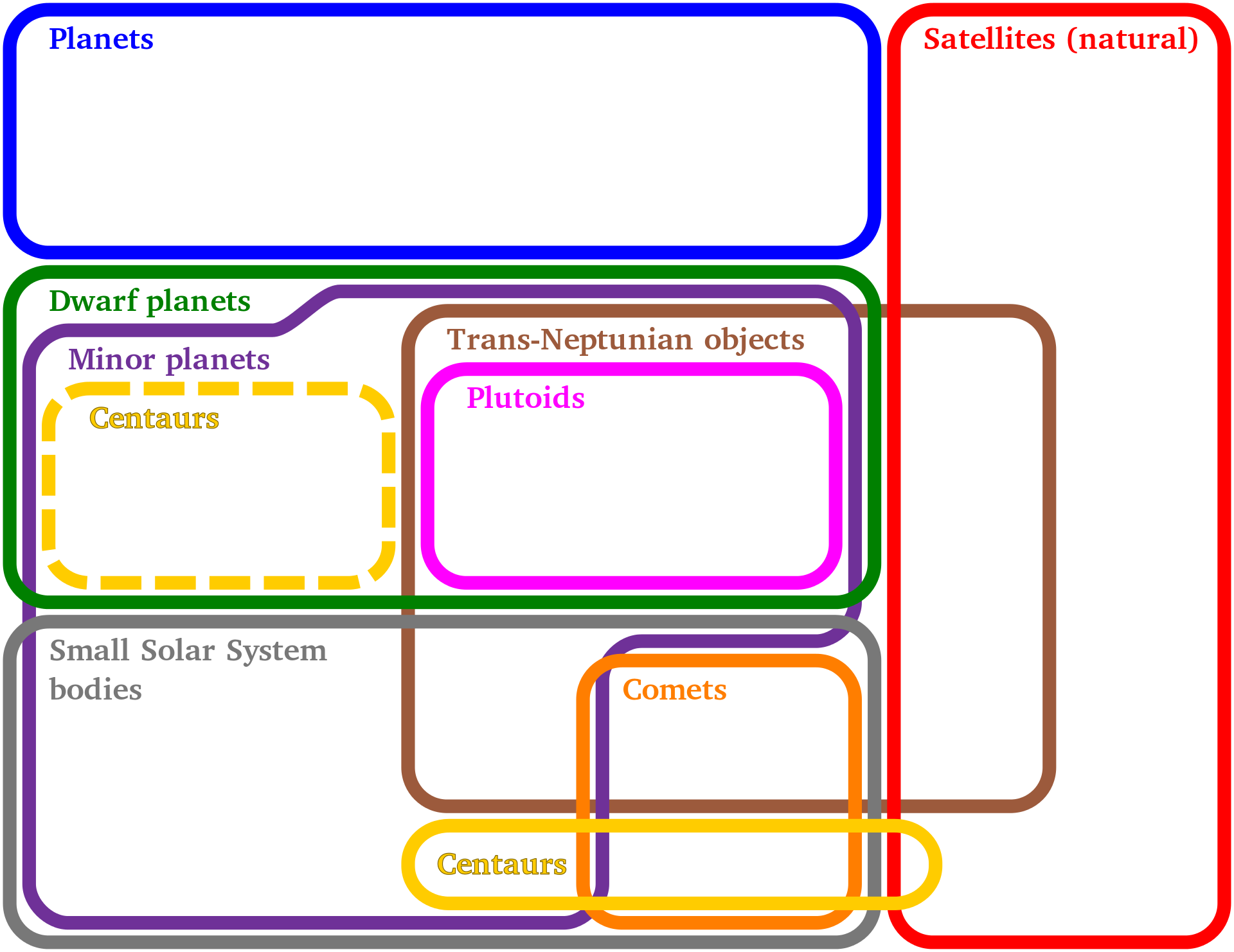

Beyond Neptune are a different set of objects with different characteristics and, presumingly, a different origin. Most are small, if icy called comets, if rocky called centaurs. Dwarf planets are called plutoids, the larges such as the Pluto/Charon system.
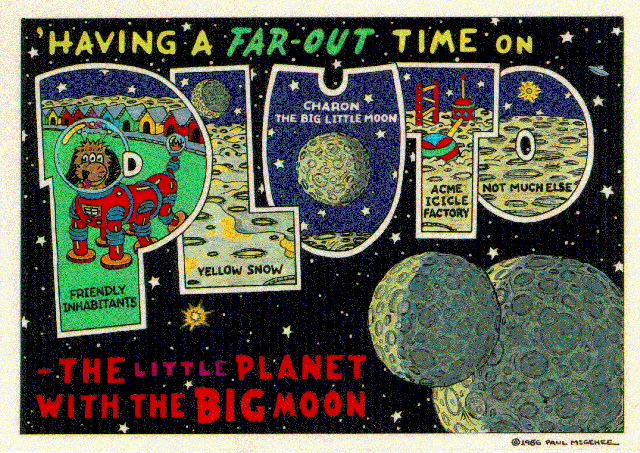
Pluto/Charon:
Pluto/Charon was discovered on February 18, 1930, making it the last planet found in our Solar System. Technically, Pluto is not an independent planet, but rather the largest member of an outer asteroid field called the Kuiper Belt. However, for historical reasons, we still call it a planet, although it is now classified as a dwarf planet. The debate between planet and dwarf planet came to a head on August 24, 2006, with an IAU resolution that created an official definition for the term "planet". According to this resolution, there are three conditions for an object in the Solar System to be considered a planet:
Pluto fails to meet the third condition, because its mass is only 0.07 times that of the mass of the other objects in its orbit (Earth's mass, by contrast, is 1.7 million times the remaining mass in its own orbit). The IAU further decided that bodies that, like Pluto, meet criteria 1 and 2 but do not meet criterion 3 would be called dwarf planets.
Pluto has five known moons: Charon (the largest, with a diameter just over half that of Pluto), Styx, Nix, Kerberos, and Hydra. Pluto and Charon are sometimes considered a binary system because the barycenter of their orbits does not lie within either body. The IAU has not formalized a definition for binary dwarf planets, and Charon is officially classified as a moon of Pluto.
In September 2016, astronomers announced that the reddish-brown cap of the north pole of Charon is composed of tholins, organic macromolecules that may be ingredients for the emergence of life, and produced from methane, nitrogen and related gases released from the atmosphere of Pluto and transferred over about 19,000 km (12,000 mi) distance to the orbiting moon.
On July 14, 2015, the New Horizons spacecraft became the first spacecraft to fly by Pluto. During its brief flyby, New Horizons made detailed measurements and observations of Pluto and its moons. On October 25, 2016, at 05:48 pm ET, the last bit of data (of a total of 50 billion bits of data; or 6.25 gigabytes) was received from New Horizons from its close encounter with Pluto on July 14, 2015.
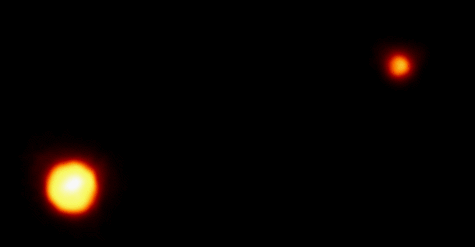
Pluto/Charon is usually farther from the Sun then any of the eight planets with a mean distance of 39.4 A.U.'s; however, due to the eccentricity of its orbit, it is closer than Neptune for 20 years out of its 249-year orbit. Pluto/Charon made its closest approach during 1989 and will remain within the orbit of Neptune until March 14, 1999. Pluto/Charon'orbit is also highly inclined by 17 degrees to the orbital plane of the other planets. Observations also show that Pluto/Charon's spin axis is tipped by 122 degrees.
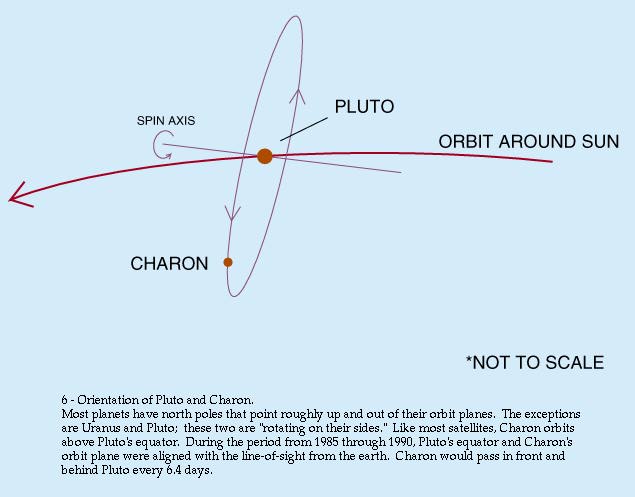
Pluto/Charon is an enigma for its orbital irregularites and how it could have formed as a binary planet. But mostly for the fact that it is a Terrestrial world out beyond the Jovian worlds, difficult to explain in the context of the protoplanet hypothesis for the origin of the solar system.
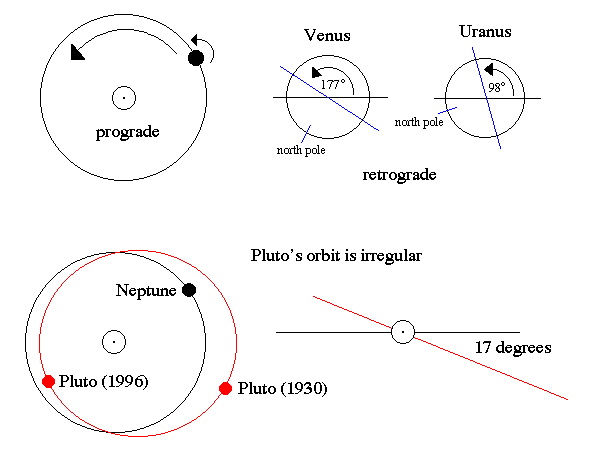
Despite Pluto's orbit appearing to cross that of Neptune when viewed from directly above, the two objects' orbits are aligned so that they can never collide or even approach closely. At the simplest level, one can examine the two orbits and see that they do not intersect. When Pluto is closest to the Sun, and hence closest to Neptune's orbit as viewed from above, it is also the farthest above Neptune's path. Pluto's orbit passes about 8 AU above that of Neptune, preventing a collision. Pluto's ascending and descending nodes, the points at which its orbit crosses the ecliptic, are currently separated from Neptune's by over 21 degrees.
This alone is not enough to protect Pluto; perturbations from the planets (especially Neptune) could alter aspects of Pluto's orbit (such as its orbital precession) over millions of years so that a collision could be possible. Some other mechanism or mechanisms must therefore be at work. The most significant of these is that Pluto lies in the 2:3 mean-motion resonance with Neptune: for every two orbits that Pluto makes around the Sun, Neptune makes three. The two objects then return to their initial positions and the cycle repeats, each cycle lasting about 500 years. This pattern is such that, in each 500-year cycle, the first time Pluto is near perihelion, Neptune is over 50 behind Pluto. By Pluto's second perihelion, Neptune will have completed a further one and a half of its own orbits, and so will be a similar distance ahead of Pluto. Pluto and Neptune's minimum separation is over 17 AU, which is greater than Pluto's minimum separation from Uranus (11 AU).
The 2:3 resonance between the two bodies is highly stable, and is preserved over millions of years. This prevents their orbits from changing relative to one another; the cycle always repeats in the same way, and so the two bodies can never pass near each other. Thus, even if Pluto's orbit were not inclined, the two bodies could never collide.
Pluto/Charon Surface Features:
The plains on Pluto's surface are composed of more than 98 percent nitrogen ice, with traces of methane and carbon monoxide. Nitrogen and carbon monoxide are most abundant on the anti-Charon face of Pluto (around 180 longitude, where Tombaugh Regio's western lobe, Sputnik Planitia, is located), whereas methane is most abundant near 300 east. The mountains are made of water ice. Pluto's surface is quite varied, with large differences in both brightness and color. Pluto is one of the most contrastive bodies in the Solar System, with as much contrast as Saturn's moon Iapetus. The color varies between charcoal black, dark orange and white. Pluto's color is more similar to that of Io with slightly more orange, significantly less red than Mars.

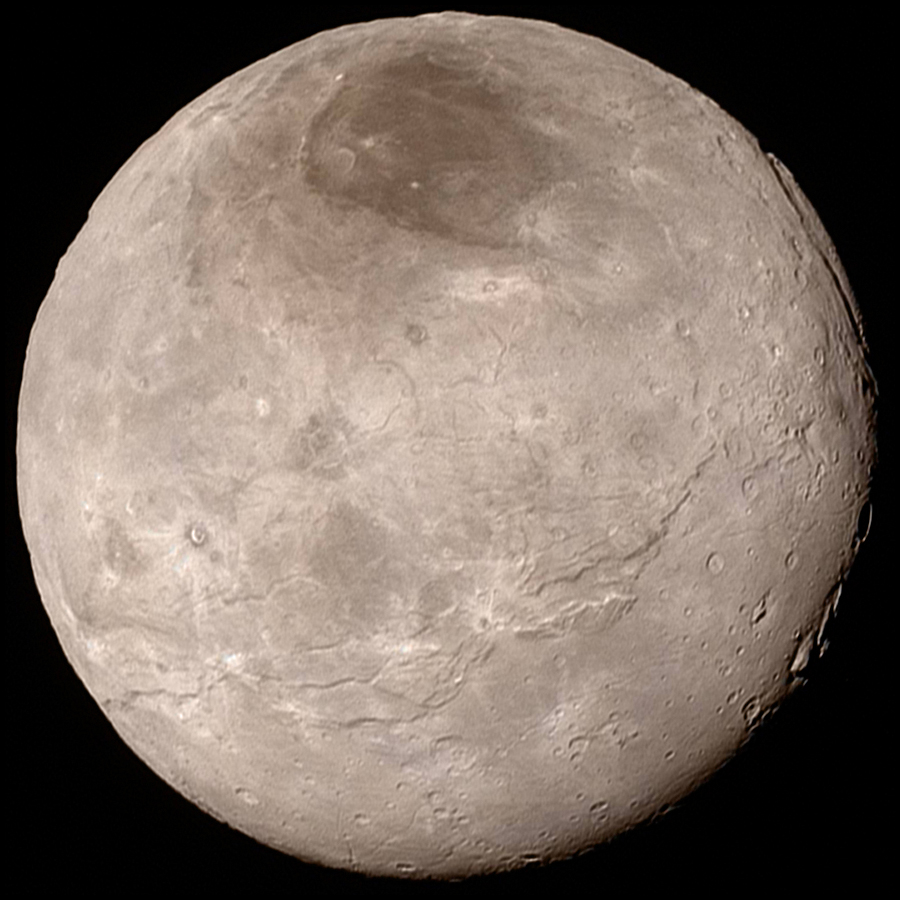
Pluto and Charon
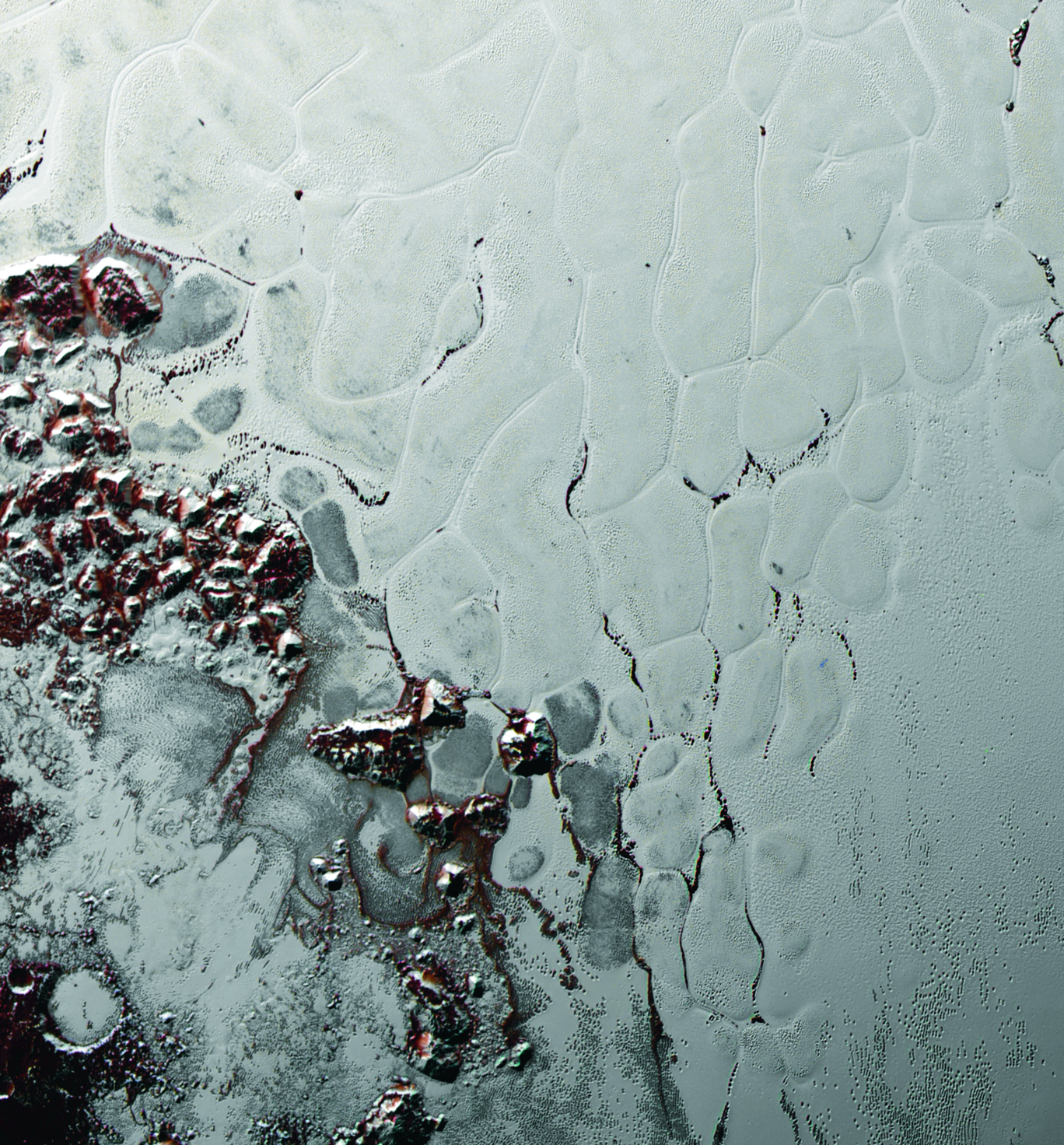
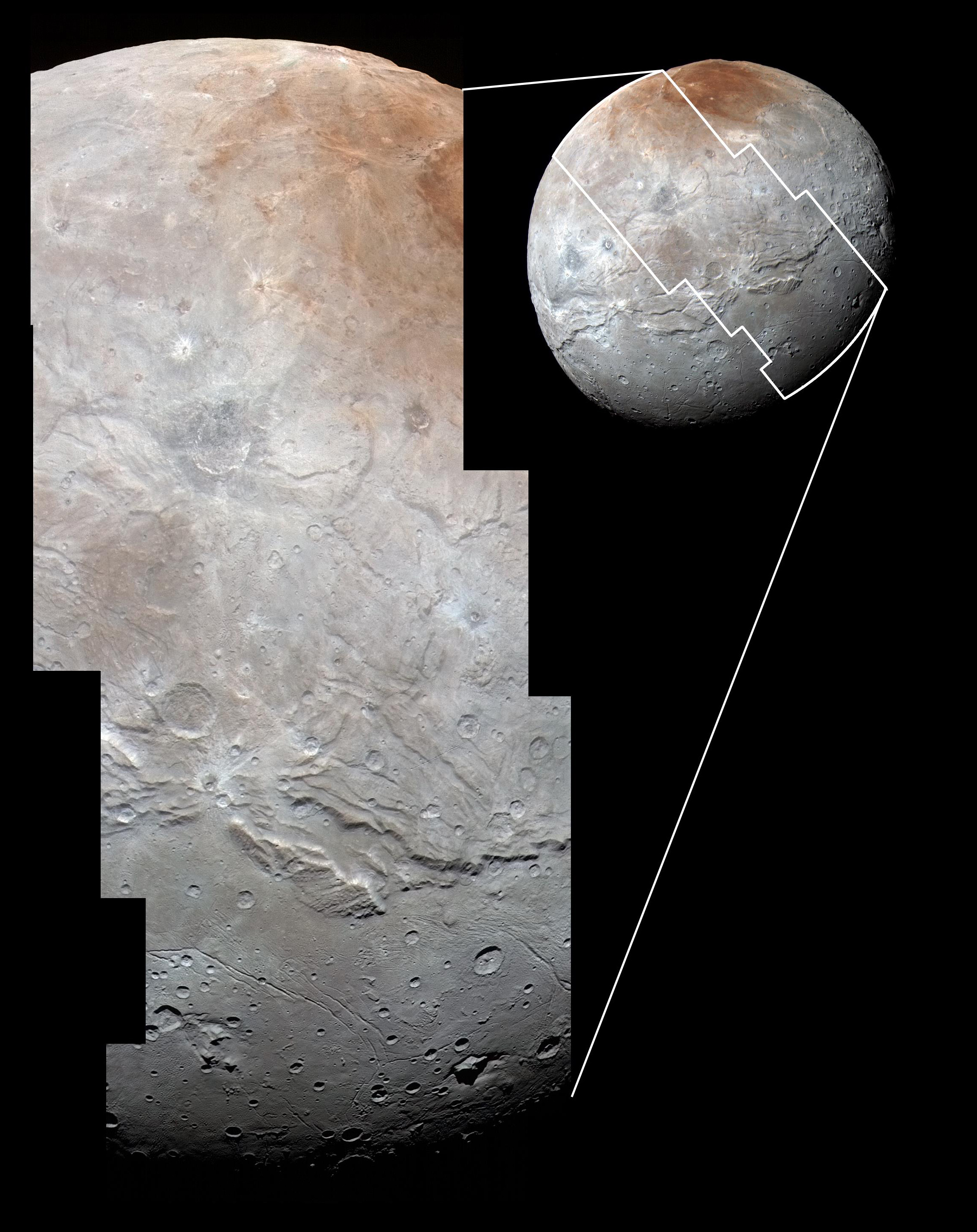
Pluto/Charon Interiors:
Pluto's density is 1.86 g/cm3. Because the decay of radioactive elements would eventually heat the ices enough for the rock to separate from them, scientists expect that Pluto's internal structure is differentiated, with the rocky material having settled into a dense core surrounded by a mantle of water ice. The diameter of the core is hypothesized to be approximately 1700 km, 70% of Pluto's diameter. It is possible that such heating continues today, creating a subsurface ocean of liquid water some 100 to 180 km thick at the coremantle boundary.
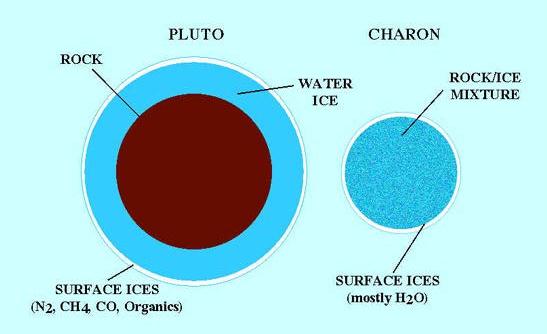
Kuiper Belt:
The Kuiper belt is a circumstellar disc in the Solar System beyond the planets, extending from the orbit of Neptune (at 30 AU) to approximately 50 AU from the Sun. It is similar to the asteroid belt, but it is far larger 20 times as wide and 20 to 200 times as massive. Like the asteroid belt, it consists mainly of small bodies, or remnants from the Solar System's formation. Although many asteroids are composed primarily of rock and metal, most Kuiper belt objects are composed largely of frozen volatiles (termed "ices"), such as methane, ammonia and water. The Kuiper belt is home to three officially recognized dwarf planets: Pluto, Haumea, and Makemake. Some of the Solar System's moons, such as Neptune's Triton and Saturn's Phoebe, are also thought to have originated in the region.
The Kuiper belt should not be confused with the theorized Oort cloud, which is a thousand times more distant and is mostly spherical. The objects within the Kuiper belt, together with the members of the scattered disc and any potential Hills cloud or Oort cloud objects, are collectively referred to as trans-Neptunian objects (TNOs).
Pluto is the largest and most-massive member of the Kuiper belt and the largest and the second-most-massive known TNO, surpassed only by Eris in the scattered disc. Originally considered a planet, Pluto's status as part of the Kuiper belt caused it to be reclassified as a dwarf planet in 2006. It is compositionally similar to many other objects of the Kuiper belt, and its orbital period is characteristic of a class of KBOs, known as "plutinos", that share the same 2:3 resonance with Neptune.
There are at least 70,000 "trans-Neptunians" with diameters larger than 100 km in the radial zone extending outwards from the orbit of Neptune (at 30 AU) to 50 AU. Observations show that the trans-Neptunians are mostly confined within a thick band around the ecliptic, leading to the realization that they occupy a ring or belt surrounding the sun. This ring is generally referred to as the Kuiper Belt.
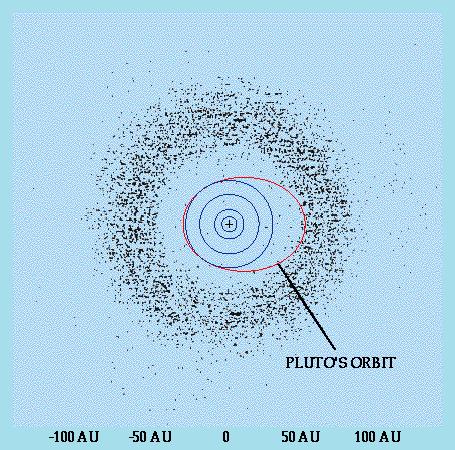

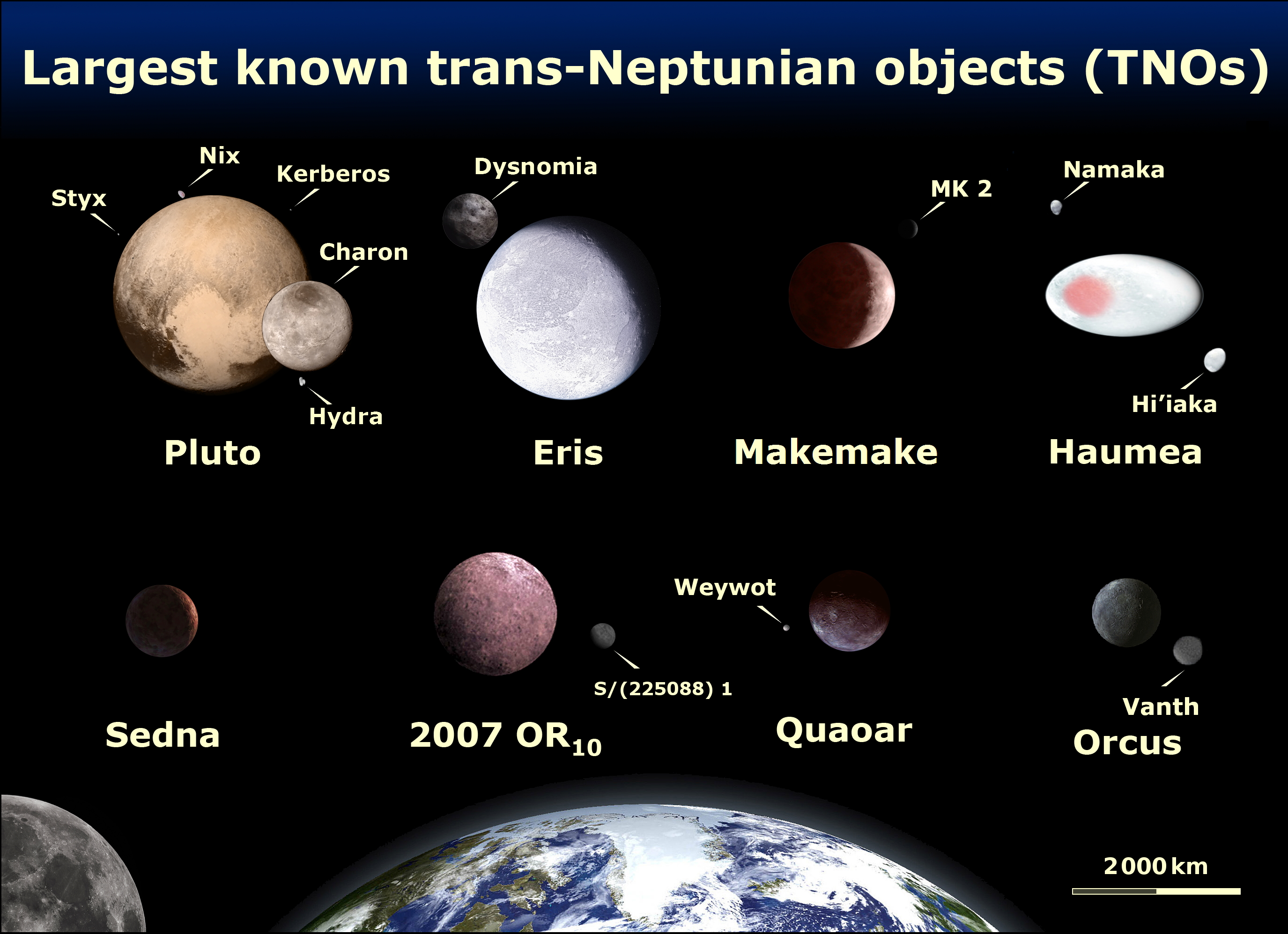
Analysis indicates that Kuiper belt objects are composed of a mixture of rock and a variety of ices such as water, methane, and ammonia. The temperature of the belt is only about 50 K, so many compounds that would be gaseous closer to the Sun remain solid. The densities and rockice fractions are known for only a small number of objects for which the diameters and the masses have been determined.

|
|

|